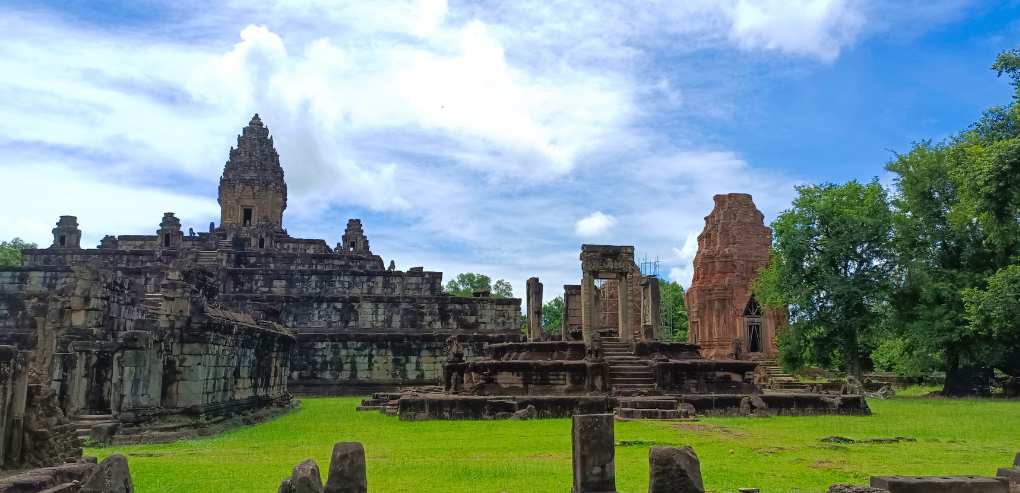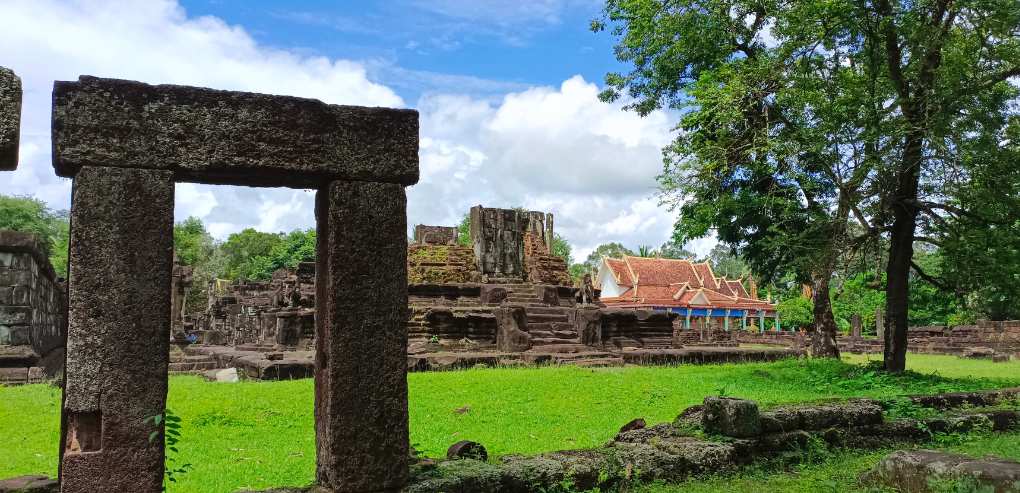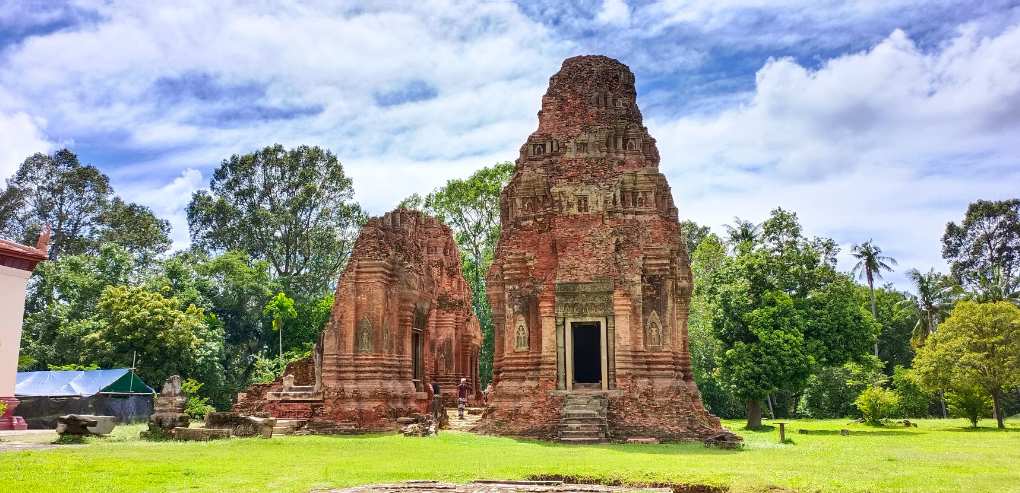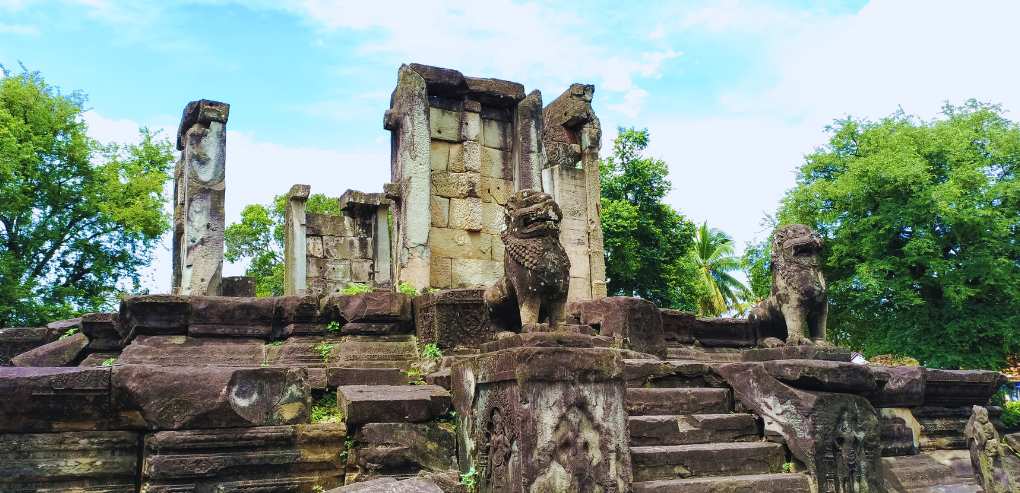Bakong Temples – A Photographic Odyssey into Cambodia’s Architectural Heritage
Exploring the ancient temples of Cambodia can be quite a challenge, even for seasoned travelers. If you’re like me, you might have felt overwhelmed trying to navigate and understand the rich architectural heritage of these sites.
This blog will help shed light on one such gem – Bakong Temple – with its unique blend of sandstone architecture and intricate carvings. Get ready to embark on a photographic voyage into Cambodia’s illustrious past!
Key Takeaways
- Bakong Temple is the first temple mountain made of sandstone in Siem Reap, showcasing Cambodia’s rich architectural heritage.
- Dedicated to Shiva by King Indravarman I, Bakong Temple holds immense significance in Cambodia’s cultural and historical legacy.
- The temple’s unique blend of architectural styles and intricate carvings offer a fascinating glimpse into Cambodia’s rich cultural heritage.
- Through captivating photography, immerse yourself in the stunning beauty and intricate details of Bakong Temple, preserving its essence for future generations.
Bakong Temple: An Overview
Bakong Temple is the first temple mountain of sandstone in Siem Reap and is dedicated to Shiva by King Indravarman I.
First temple mountain of sandstone in Siem Reap
Bakong Temple holds the honor of being Siem Reap’s first temple mountain made primarily from sandstone. As I walked its ancient grounds, it became clear how this structure set a significant precedent for Cambodian temple design.
The use of sandstone sets Bakong apart and gives it an intricately detailed appearance that is hard to miss. Its scale and grandeur are instantly striking, backed by enduring tales of King Indravarman I dedicating this architectural marvel to Shiva.
It paints a vivid picture of the Khmer empire’s zenith and their reverence for Mount Meru, considered in Hinduism as the home of the gods. The visual journey through Bakong Temple offers more than just beautiful views; it provides a unique chance to delve deep into Cambodia’s rich cultural legacy and profound understanding of cosmic order manifested in stone.
Dedicated to Shiva by Indravarman I
As I stood in awe before the grandeur of Bakong Temple, it became apparent that this architectural masterpiece held great significance to Cambodia’s heritage. Dedicated to Shiva by Indravarman I, this temple stands as a testament to the Khmer empire’s devotion to their gods.
It is believed that King Indravarman I built and dedicated Bakong Temple as a symbol of his faith and reverence for Shiva. The temple’s construction from sandstone showcases intricate details and carvings, making it a true marvel of craftsmanship.
As travelers explore this sacred site, they can’t help but be captivated by its spiritual aura and the rich history it represents.
Representation of Mt Meru
The Bakong Temple in the Angkor area of Cambodia is an architectural masterpiece that represents Mt Meru, a mythical mountain in Hindu and Buddhist cosmology. Constructed in a temple mountain style, the temple’s layout mimics the sacred mountain’s shape and symbolism.
As you explore the temple, you’ll notice its intricate carvings and designs depicting various gods, goddesses, and mythical creatures that are often associated with Mt Meru. This representation of Mt Meru not only showcases the Khmer rulers’ devotion to Shiva but also offers a glimpse into Cambodia’s rich cultural heritage.
Exploring Bakong Temple
The temple’s unique architectural styles and intricate carvings offer a fascinating glimpse into Cambodia’s rich cultural heritage.
Unique architectural styles
The Bakong Temple showcases unique architectural styles that make it a must-visit destination for architectural enthusiasts. This ancient temple, built during the Khmer empire, blends two different architectural styles into one magnificent structure.
Its design combines elements of both the pre-Angkorian and Angkorian eras, creating a truly distinct and captivating aesthetic. The temple’s intricate carvings and detailed designs further enhance its allure, providing visitors with a glimpse into Cambodia’s rich cultural heritage.
Exploring the unique architectural styles of Bakong Temple is an opportunity to witness the remarkable craftsmanship and creativity of the Khmer rulers.
Intricate carvings and designs
As I explored the magnificent Bakong Temple in Cambodia, I was captivated by its intricate carvings and designs. Every surface of the temple seemed to tell a story, with delicate details that showcased the incredible craftsmanship of the Khmer empire.
The sandstone walls were adorned with elaborate bas-reliefs depicting scenes from Hindu mythology, ancient battles, and everyday life during that time. Each carving was meticulously carved by hand, showcasing the skill and precision of the artisans who created them.
From intricately designed doorways to beautifully sculpted pillars, every corner of Bakong Temple revealed a new level of artistry and dedication. It truly felt like stepping into a world where history came alive through these exquisite carvings.
The attention to detail in Bakong Temple’s designs is simply astonishing. From ornate floral patterns to intricate depictions of deities and celestial beings, each carving displayed an incredible level of artistry and symbolism.
These carvings not only served as decorative elements but also had deep spiritual significance for worshippers during the Khmer era.
Experiencing these intricate carvings firsthand allowed me to appreciate Cambodia’s rich cultural heritage even more deeply. The masterful craftsmanship showcased at Bakong Temple is a testament not only to the skills of those who built it centuries ago but also to their reverence for art and devotion.
The Temples of Angkor: A Cultural Heritage
The temples of Angkor are not only a cultural heritage but also hold immense importance as a UNESCO World Heritage Site.
Importance of Angkor temples as a UNESCO World Heritage Site
As a traveler to Siem Reap and Angkor, it is important to understand the significance of the Angkor temples as a UNESCO World Heritage Site. These ancient structures are not only architectural wonders but also bear immense cultural and historical value.
Their inclusion in the UNESCO list ensures their preservation and recognition on a global scale. The Angkor temples, including Bakong Temple, showcase the rich heritage of Cambodia’s Khmer empire and allow us to delve into the country’s glorious past.
Exploring these temples provides a unique opportunity to witness firsthand the mastery of Khmer architecture and gain insights into Cambodian history that cannot be found anywhere else.
The significance of Bakong Temple in Cambodia’s architectural heritage
Bakong Temple holds immense significance in Cambodia’s architectural heritage. As the first temple built mainly of stone, it served as a model for the later Angkor temples. Dedicated to Shiva and constructed by King Indravarman I, Bakong Temple represents the rich cultural and historical legacy of Cambodia’s Khmer empire.
Its unique mandala layout, resembling mythical Mount Meru, showcases intricate carvings and designs on its sandstone structure. This temple stands as a testament to Cambodia’s architectural excellence and offers visitors an opportunity to delve into the fascinating history of the Khmer empire.
A Photographic Journey into Bakong Temple
Immerse yourself in the stunning beauty and intricate details of Bakong Temple with a photographic exploration that captures the history and culture of Cambodia through vibrant images.
Capturing the beauty and details of the temple through photography
As I wandered through the mesmerizing Bakong Temple, I couldn’t help but be captivated by its intricate details and breathtaking beauty. With my camera in hand, I focused on capturing every angle, every carving, and every architectural feature that made this temple so unique.
The delicate sandstone carvings told stories of Cambodia’s rich history and culture, while the elaborate designs showcased the skill and craftsmanship of Khmer artisans. Through my lens, I was able to freeze these moments in time, allowing me to experience the history and magnificence of Cambodia’s architectural heritage again and again.
It was truly a photographic journey unlike any other – a chance to preserve the essence of this incredible temple for generations to come.
Experiencing the history and culture of Cambodia through images
As I explore Bakong Temple through my lens, I am transported back in time to the rich history and culture of Cambodia. Each image captures the intricate carvings and architectural details that tell the story of the Khmer empire.
From the mythical Mount Meru-inspired layout to the dedication to Shiva by King Indravarman I, these images bring to life the significance of Bakong Temple as a cultural and historical site in Cambodia.
Through photography, I am able to immerse myself in Cambodia’s glorious past, preserving its architectural gems for generations to come.
Conclusion
Embark on a captivating journey through Cambodia’s architectural heritage with Bakong Temples. Through mesmerizing photography, you can capture the intricate details and beauty of this ancient masterpiece.
Immerse yourself in the rich history and cultural legacy of Cambodia as you explore the enchanting Bakong Temples. Rediscover the wonders of the Khmer empire and experience the magic of this UNESCO World Heritage Site firsthand.
Bakong Temples – FAQs
What are the Bakong Temples?
The Bakong Temples are a collection of ancient architectural structures located in Cambodia that showcase the country’s rich cultural heritage.
Can I visit the Bakong Temples?
Yes, the Bakong Temples are open to visitors who want to explore and admire their unique architecture and historical significance.
Are there any entrance fees for visiting the Bakong Temples?
Yes, there is an entrance fee to visit the Bakong Temples. The exact amount may vary, so it’s best to check with the local authorities or tour operators for current pricing information.
Do I need a guide to explore the Bakong Temples?
While having a guide can enhance your understanding of the history and significance of these temples, it is not necessary. Visitors can explore and appreciate them on their own as well.





